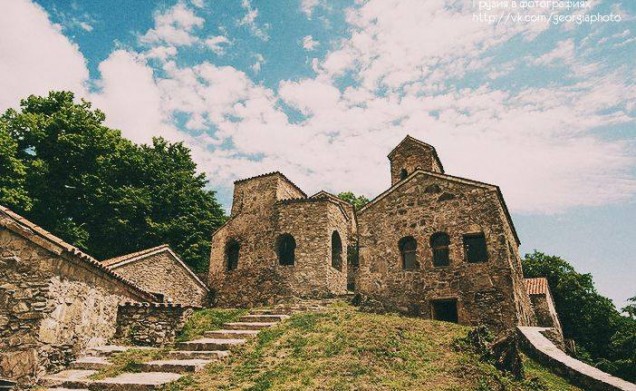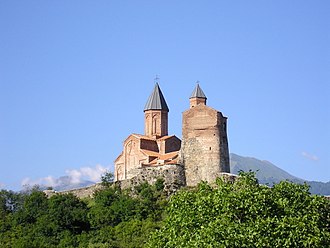Churches come aplenty in Georgia, with over 90% of its population professing to be Christian Orthodox. We've put together some of our favorite religious and tourist spots, though there are many more either ruined, renovated, or getting there. Enjoy your tour!
NEKRESI
Driving through Kakheti, Nekresi is visible from kilometers away, carved daringly into a mountainside, its red roofs contrasting against the trees around it.
The site was established in the 4th century under the patronage of King Trdat, King of Iberia, and the religious guidance of St. Abibos Nekreseli, one of the thirteen Syrian fathers. The complex includes several ecclesiastical buildings: the Blessed Virgin Church (VI-VII century), a basilica church that is one of the earliest surviving Christian churches in Georgia (IV century), a two-story bishop’s palace (IX century), a four-story tower (XVI century), and a wine cellar.

Arriving to Nekresi, visitors can walk up the steep, winding road to the complex (the sign says it’s 1.5 km, but it feels like a lot longer!) or pay 1.50 GEL to take a shuttle bus. Inside the main church, wine is, unusually, for sale. The church also has a glass box filled with the bones of the monks who have served at the monastery, a striking memento mori.
Nekresi is definitely a must-see in Kakheti – if only for the views from the top!
GREMI
Gremi is a monastery, church, and castle complex in Kakheti, near Georgia’s easternmost border. The stunning setting has vineyards and rolling hills in one direction, and the sharp, snowcapped mountains that divide Kakheti from Dagestan, Russia, in the other.

The Archangels’ Church is perched on a hill, the orange-hued stones and bright green top visible from kilometers around. The architecture is influenced by local interpretations of Persian styles. The complex is composed of the 16th century Church of the Archangels Michael and Gabriel, a three-story castle, a bell tower and a wine cellar. Most of the encircling wall survives. You can also explore the remnants of a hidden escape tunnel leading to the Intsobi River.
There is a small gift shop where you can buy the standard souvenirs and a great museum located in the bell tower that presents several archaeological artifacts and a cannon from the 16th century.
BAGRATI CATHEDRAL
The 11th century Bagrati Cathedral is something truly impressive to see- cool cream stones and bright turquoise roof, perched on a hilltop outside of Georgia’s second largest city.
Bagrati Cathedral was built in the early years of the 11th century, during the reign of King Bagrat III. In 1692, it was severely damaged by Ottoman troops who had invaded the Kingdom of Imereti. The incident caused the cupola and ceiling to collapse.

Take the cable car up from the old town unless you are devoted to the walk up- the view once you get there is well worth the climb!
Inside you’ll find all the elements typical of an Orthodox church- the icons, partial frescoes (not as many as in some due to the constant invasions and attacks on the cathedral), the lulling smell of incense and the calm quiet- especially because there tend to be fewer tourists here than you might expect. The “highlight” is the Shroud of Jesus with an imprint of his face.
Take the path down and pop into the Botanical Gardens for a bit of nature! English-speaking guides are available.
Bagrati, following essential renovation works to restore it to a functional building, was removed from the UNESCO World Heritage List.
GERGETI
Surrounded by the mountains of the Caucasus, the Gergeti Trinity Chruch is one of the most famous travel destinations in Georgia. The church was built in the 14th century and is the only cross-cupola church in Khevi province. Even during the soviet era, when all religious services were prohibited, the church remained a popular tourist destination. Only in the 1990s was the church was returned to the Georgian Orthodox Church.

Nowadays, it is not only a church that is located above Stepantsminda, but also a monastery. In spite of the very cold temperatures, monks live in a building right next to the church. Unlike other churches in Georgia, taking pictures is not allowed inside the holy walls.
Main photo by Levan Gokadze.
